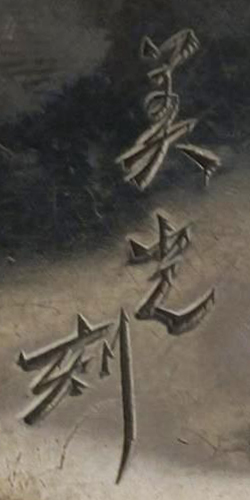
Mitsukoshi [三越] (1673 ~ today)

Mitsui Takatoshi (left), the founder of Echigoya, the predecessor of Mitsukoshi (right).

Echigoya (left), Mitsui group (right) and Mitsui bank (behind). Circa 1900.

Mitsukoshi Gofukuten (left) and Osuke Hibi (right) in 1904.

Inside the company store in 1894 (left) and 1904 (right).

New building featuring Renaissance-style (1914).

Rebuilt store in 1925, after the Great Great Kanto Earthquake.

Mitsukoshi store in Dalian (Dairen), China, in 1912 (left) and 1927 (right).

Mitsukoshi stores in Ginza (left) and Osaka (right). 1930s.

Statue of Magokoro before (left) and after (right) installation in the Nihonbashi Store.
Addresses and locations
No. 7, Surugacho, Nihombashiku, Tokyo
1-4-1 Nihonbashi-Muromachi, Chuo, Tokyo
Marks
The trade mark of Mitsukoshi company
Marks on silver items:
純銀三越
純 (sterling) 銀 (silver) 三越 (Mitsukoshi)
Jungin Mitsukoshi
Sterling silver, Mitsukoshi
純銀三越
純 (sterling) 銀 (silver) 三越 (Mitsukoshi)
Jungin Mitsukoshi
Sterling silver, Mitsukoshi
Marks on silver items:
銀製三越
銀 (silver) 製 (make) 三越 (Mitsukoshi)
Gin sei Mitsukoshi
Silver, Made by Mitsukoshi
銀製三越
銀 (silver) 製 (make) 三越 (Mitsukoshi)
Gin sei Mitsukoshi
Silver, Made by Mitsukoshi
Stickers and labels
Individual marks of artists from the Mitsukoshi company
洲山
Suyama
Suyama
元輝
Motoki
(also worked for the
Shirokiya company)
Motoki
Shirokiya company)
美光
Yoshimitsu
(also worked for the
T. Nakamura company)
Yoshimitsu
T. Nakamura company)
秀友
Hidemoto
Hidemoto
Advertisements
Business cards
Postcards
Examples (from the web)
References
"Japan In The Taisho Era", by Iwata Nishizawa, 1917, pp. 132-133.
"The Universal Dictionary of Foreign Business in Modern China", by Huang Guangyu, 1995, p. 11.
"Japan to-day; a souvenir of the Anglo-Japanese exhibition held in London 1910", by Mochizuki Kotaro, 1910, pp. 491-492.
Antique boxes website.
Wikipedia article.













































































































































